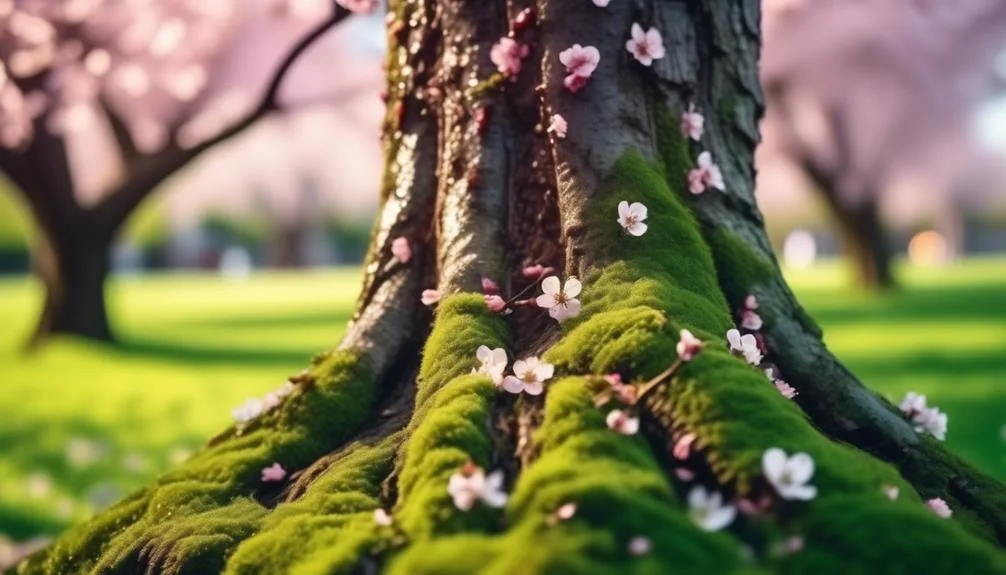Curious about whether you can eat the sweet sap from cherry trees? Known as cherry gum, this sap has a long history of use in different cultures for its potential health benefits. But is it safe to consume?
Before you try it, it's important to understand its edibility and safety factors. Exploring the nutritional value, potential risks, and safe consumption methods of cherry tree sap might surprise you.
Edibility of Cherry Tree Sap
If you've ever wondered whether cherry tree sap is edible, the answer is both fascinating and cautionary.
The taste profile of cherry tree sap is surprisingly sweet, with a subtle hint of cherry flavor. However, it's important to note that consuming cherry tree sap isn't recommended due to potential toxicity and the risk of allergic reactions.
While some indigenous cultures have historically used the sap for medicinal purposes, its culinary uses are limited. The sap contains cyanogenic glycosides, which can release cyanide when metabolized by the body. Therefore, it's crucial to exercise extreme caution when considering the edibility of cherry tree sap.
As tempting as it may be to try this sweet, cherry-flavored substance, it's best to appreciate the cherry tree for its delicious fruits rather than its potentially hazardous sap.
Nutritional Value of Cherry Tree Sap
The nutritional composition of cherry tree sap includes a blend of sugars, organic acids, and trace elements, providing a glimpse into its potential dietary value.
Cherry tree sap is rich in natural sugars such as glucose, fructose, and sucrose, which can provide a quick source of energy.
Additionally, the sap contains organic acids like malic and citric acid, which contribute to its tangy flavor profile.
When it comes to trace elements, cherry tree sap contains small amounts of minerals like potassium, calcium, and magnesium, offering a nutritional boost.
While the culinary uses of cherry tree sap are limited due to its relatively small quantity and seasonal availability, its potential health benefits may make it an intriguing addition to the diet.
Further research is needed to explore its medicinal properties and potential applications in the culinary world.
Potential Risks of Consuming Cherry Tree Sap
As you consider the potential dietary value of cherry tree sap, it's crucial to be aware of the potential risks associated with consuming it.
While cherry tree sap has been used in traditional medicine and cooking, there are potential risks that need to be considered. One of the main concerns is the potential for allergic reactions. Some individuals may be allergic to components in cherry tree sap, leading to symptoms such as itching, swelling, or even anaphylaxis in severe cases.
Additionally, consuming cherry tree sap that hasn't been properly processed or purified may pose health implications. Bacterial contamination or toxins present in the sap could lead to gastrointestinal issues or other health problems.
Therefore, it's important to exercise caution and consider these potential risks before consuming cherry tree sap.
Ways to Safely Consume Cherry Tree Sap
To safely consume cherry tree sap, it's essential to ensure proper processing and purification to minimize the risk of potential health implications.
First, ensure safety precautions by wearing gloves and using clean, sterile equipment when harvesting the sap.
Once collected, boil the sap to eliminate any bacteria or impurities. This can be done by placing the sap in a pot over low heat and simmering for at least 10 minutes.
After boiling, strain the sap through a fine mesh sieve to remove any remaining debris.
Next, consider different cooking methods such as incorporating the purified sap into recipes like syrups, sauces, or jellies.
Alternatively, you can let the sap cool and consume it as a refreshing beverage.
These methods will help to ensure that the cherry tree sap is safely consumed, minimizing potential health risks.
Conclusion: Is Cherry Tree Sap Edible?
With proper processing and purification, cherry tree sap can be safely consumed, minimizing potential health risks. The extraction process involves tapping the tree and collecting the sap, which is then processed to remove impurities.
Culinary uses of cherry tree sap include making syrup, vinegar, and even wine. Additionally, the sap has been historically used for its medicinal properties, such as treating coughs and colds, and it's rich in antioxidants.
It's important to note that consuming cherry tree sap in its raw form may pose health risks due to potential contaminants, so proper processing is crucial.
Conclusion
Incorporating cherry tree sap into your diet can provide nutritional benefits thanks to its antioxidants and other valuable compounds.
Remember to consume it in moderation to avoid potential risks.
Whether used in recipes or as a natural sweetener, savor this unique and delicious natural treat responsibly.

My interest in trees started when I first saw the giant sequoias in Yosemite.
I was a teenager then, and I remember thinking, “I need to learn more about this.”
That moment stuck with me.
A few years later, I went on to study forestry at Michigan Tech.
Since graduating, I’ve worked in a mix of hands-on tree care and community education.
I’ve spent over ten years helping people understand how to plant, maintain, and protect the trees in their neighborhoods.
I don’t see trees as just part of the landscape.
They are living things that make a real difference in our daily lives.
